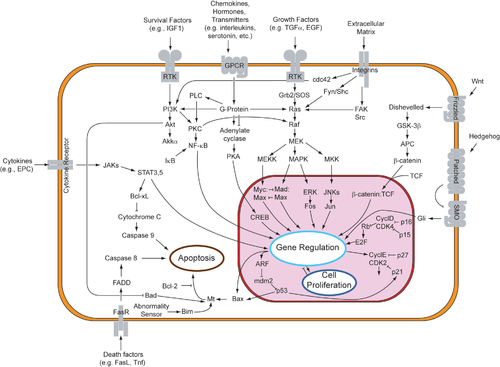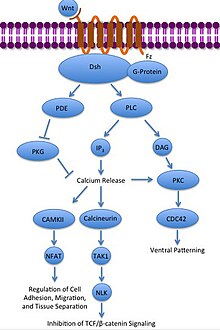Paracrine signaling
In fact, different organs in the body - even between different species - are known to utilize a similar sets of paracrine factors in differential development.Binding of a paracrine factor to its respective receptor initiates signal transduction cascades, eliciting different responses.Although the FGF family of paracrine factors has a broad range of functions, major findings support the idea that they primarily stimulate proliferation and differentiation.[2][3] To fulfill many diverse functions, FGFs can be alternatively spliced or even have different initiation codons to create hundreds of different FGF isoforms.Mutant forms of the Kit receptor, which fire constitutively in a ligand-independent fashion, are found in a diverse array of cancerous malignancies.[11] Research on thyroid cancer has elucidated the theory that paracrine signaling may aid in creating tumor microenvironments.[12] Effectively, multiple bindings of ligands to the RTK receptors overstimulates the Ras-Raf-MAPK pathway, which overexpresses the mitogenic and invasive capacity of cells.[18] Research on paracrine signaling through the JAK-STAT pathway revealed its potential in activating invasive behavior of ovarian epithelial cells.[20] The Hedgehog protein family is involved in induction of cell types and the creation of tissue boundaries and patterning and are found in all bilateral organisms.Hedgehog proteins produce key signals for the establishment of limb and body plan of fruit flies as well as homeostasis of adult tissues, involved in late embryogenesis and metamorphosis.Sonic hedgehog (SHH) has various roles in vertebrae development, mediating signaling and regulating the organization of central nervous system, limb, and somite polarity.Inhibition of Smoothened causes the Cubitus interruptus (Ci), Fused, and Cos protein complex attached to microtubules to remain intact.[23][24][25] The Hedgehog Signaling pathway is critical in proper tissue patterning and orientation during normal development of most animals.Aberrant activation of the Hedgehog pathway has been implicated in several types of cancers, Basal Cell Carcinoma in particular.In addition, therapy-induced Hedgehog pathway activation has been shown to be necessary for progression of Prostate Cancer tumors after androgen deprivation therapy.IP3 can then bind to a receptor on the endoplasmic reticulum to release intracellular calcium stores, to induce calcium-dependent gene expression.Current research is focused on the action of the Wnt signaling pathway the regulation of stem cell choice to proliferate and self renew.[34][35][36] "TGF" (Transforming Growth Factor) is a family of proteins that includes 33 members that encode dimeric, secreted polypeptides that regulate development.[37] Many developmental processes are under its control including gastrulation, axis symmetry of the body, organ morphogenesis, and tissue homeostasis in adults.[39] The TGF-β pathway regulates many cellular processes in developing embryo and adult organisms, including cell growth, differentiation, apoptosis, and homeostasis.The R-SMAD/Co-SMAD forms a complex with importin and enters the nucleus, where they act as transcription factors and either up-regulate or down-regulate in the expression of a target gene.[39] TGF-β proteins regulate epithelia by controlling where and when they branch to form kidney, lung, and salivary gland ducts.Also, retinoic acid, the active form of vitamin A, functions in a paracrine fashion to regulate gene expression during embryonic development in higher animals.








cellular biologycell signalingcellular communicationdiffuseendocrine factorshormonescirculatory systemjuxtacrine interactionsautocrine signalingextracellularreceptorsorgansfibroblast growth factorHedgehogTGF-β superfamilysignal transductioncompetentisoformsalternatively splicedmesodermectodermretinaoptic cupPhenotypeGastrulationfibroblast growth factorstyrosinephosphorylateskinaseligandstem cell factorconformational changehomodimerizedlipid bilayercytoplasmadaptor proteinMAPK/ERK pathwaycarcinogenesisproto-oncogenehematopoiesisthyroid cancerChemokineoverexpressesmitogenicJAK-STAT signaling pathwayJanus kinaseerythropoietinerythropoiesisthrombopoietinplateletinterferontranscription factorscraniosynostosisthanatophoric dysplasiaachondroplasicChondrocyteepithelial cellsmesenchymalmetastasisHedgehog protein familyDrosophilabody planhomeostasisembryogenesismetamorphosishomologssomitepolaritySertoli cellsspermatogenesisphosphatetransmembranePatchedSmoothenedtransducedCubitus interruptusrepressoractivatorcell proliferationcancersBasal Cell Carcinomaoverexpressionandrogen deprivation therapystem-celltumorigenesisWnt proteincysteineglycoproteinsWnt pathwayplanar cell polarity (PCP) pathwayspindlemotilitycanonical pathwayFrizzledDishevelledβ-catenintranscription factormicrotubularcytoskeletongene transcriptionmorphologydivisionPrickle proteinGTPasemorphogenesis 1Rac proteincalciumphospholipaseendoplasmic reticulumdegenerative diseasecancerdimericTGF-βTGF-β pathwaycell growthdifferentiationapoptosisserinethreonineR-SMADI-SMADSMAD8/9R-SMADsimportinactivinTGF-β ligand